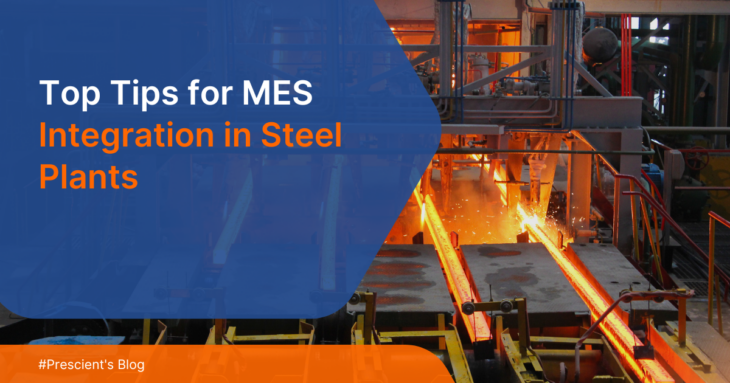How MES Enhances Production Planning in Steel Plants
Production planning in steel plants is often considered a tough balancing act. Production planners need to align resources with market demands while hitting the plant’s production targets. It’s also a constant juggling of decisions to keep things running smoothly, as production units can sometimes run into delays and material rejection. That’s where a Manufacturing Execution System (MES) comes in to improve the functioning of steel plants. By providing real-time data and overall visibility over the operations, MES helps streamline the production planning process. In this MES production planning steel blog, we’ll explore how MES can make production planning easier and more efficient. What Production Planning Is and What It Entails Production planning is a strategic process necessary for the smooth operation of steel plants. It involves the organization and coordination of resources to meet production targets while aligning the whole thing with market demands. Basically, production planning ensures that the correct quantities of steel are produced with the quality expected for the batch or as requested by the client. One of the most important goals of production planning is using available resources efficiently to save costs and eliminate waste. Production planning is also a dynamic process that adjusts to changes in production conditions and market requirements. A well-executed production plan balances all the factors involved to avoid over-planning or under-planning, both of which can negatively impact the plant’s performance and costs. The various parts of production planning involve: How MES Enhances Production Planning in Steel Plants As is evident from the nuances of production planning, it’s a process that has a lot of scope for improvement with digitization. An MES that is properly implemented can offer plenty of advantages to the steel plant. Here are 6 areas where MES production planning steel advantages are evident. 1. Real-Time Data Collection Across the Plant In steel plants, having instant data on all the areas and equipment can go a long way in keeping production on track. MES systems make this easy by providing real-time insights straight from the production floor. Plant operators can know immediately if a furnace’s temperature drops below the threshold or if there’s a blockage in material flow, which can disrupt the whole process. This immediate feedback allows planners to tweak their production plan right away and avoid delays and wasted work. 2. Enhanced Scheduling and Resource Allocation Scheduling and resource allocation are key to keeping a steel plant running on time for deliveries. MES production planning steel systems manage production by creating more accurate schedules based on real-time data on the floor. For instance, if the MES detects that the annealing section is running slower than usual because of a fault, it adjusts the schedule to prevent bottlenecks. The system also helps allocate resources like labor and materials in the right place to gain speed or keep up with the flow. MES aligns production schedules with current conditions and available resources to meet targets without overloading the equipment. 3. Predictive Maintenance and Downtime Reduction Predictive maintenance has been a breakthrough for steel plants, which have traditionally been affected by unexpected downtimes and sudden failures. The systems continuously monitor equipment performance using IIoT devices and analyze the data. By real-time and historical analysis of performance data, MES can predict when a machine might fail or need maintenance. For instance, if a visual sensor detects the unusual orientation of rebars coming out of the rolling mill, the system can alert operators before a major breakdown occurs. 4. Better Inventory Management to Reduce Costs Managing inventory in a steel plant is all about striking a fine balance. The plant needs enough raw materials and in-process goods to keep production flowing. However, having too much material in the inventory can lead the costs to skyrocket. MES systems help strike that balance by providing real time visibility into inventory levels and comparing it with running conditions and expected throughput. If supplies are running low, the system alerts the planners to reorder material before it impacts production. Conversely, it helps avoid overstocking by aligning inventory with actual production needs. By keeping inventory levels just right, MES reduces waste, cuts costs, and ensures that the production plan stays on track without unnecessary delays or excess. 5. Improved Quality Control Quality control is a critical factor in steel production as the material properties of the output depend on it. While manual quality control has challenges, MES systems take it to the next level by maintaining a strict tolerance. MES systems continuously monitor steel production so that quality standards are met at every stage. Closing Thoughts Integrating MES into steel production planning enhances how plants operate from a fundamental level. From real-time data collection to strict quality control, MES production planning steel systems make the production planning process a whole lot simpler. Digitization helps planners make better decisions and optimize resources so the plants can meet production targets on budget and stay competitive in the market. FactoryCONNECT is a cutting-edge MES solution for manufacturing units. By seamlessly integrating across your systems on the production floor, it provides real-time data, better scheduling, and improved quality control. Take control of your operations with complete visibility into the plant with FactoryCONNECT. Contact us today to learn how we can transform your steel plant!
Read MoreBest Practices for Successful MES Integration in the Steel Industry
Steel production is one of the oldest industries in the world with well-established procedures and methodologies that have sustained for decades. In the modern day, the old ways are insufficient to deal with factors such as market volatility, costs, competition, etc. Implementing an MES system optimizes the functioning of steel plants by streamlining the processes and keeping up with the market. In this article, we take a closer look at the MES integration best practices steel industry. From setting clear goals to involving the right people and choosing the right solution, we’ll cover what it takes to make your MES implementation a success. Top Best Practices for Successful MES Integration Let’s check out the best practices for successful integration in detail: 1. Identify the Need and Scope for MES The first step in MES integration is understanding why you need it and what you want it to achieve. Start by asking what specific problems you are trying to solve. It can be real-time monitoring of the temperature of the cast billets, tight control of the composition of the steel, or gaining better visibility over the entire production. Clearly defining your goals will help you have a good picture. Next, consider the scope of the solution’s implementation. MES systems are often broad and cover everything from inventory management to real-time monitoring and client communication. Determine which areas of your plant will benefit the most to pick the right solution. 2. Discuss MES Features and Scope With All Stakeholders Once you’ve identified the need for MES, it’s essential to involve all stakeholders, from the level of upper management to the operators, IT teams, and even the suppliers, in discussions about its features and scope. Explain how the MES will impact their work and highlight the benefits. For example, automating reporting can reduce manual tasks for operators in the form of data gathering and report writing. Employees also won’t have to be around machinery all the time with data being available on their mobile devices. Transparency is key, especially for older workers who may fear technology changes. Address their concerns openly and show how MES will enhance, not replace, their roles. 3. Develop User Requirements for the System Part of MES integration best practices steel industry starts with understanding the specific needs of those who will use it daily. Not all features offered by a solution are necessarily useful in the plant. Therefore, developing user requirements, which involves gathering input from everyone involved, from operators on the floor to IT specialists, is necessary. What do they need the system to do? Floor operators might require easy access to real-time data on production metrics, while IT teams would prioritize seamless integration with standardized data with existing systems. By involving users in this process, you ensure the MES is tailored to the plant’s unique needs. 4. Prepare Gap Analysis With Existing System and Interfaces A major part of implementing MES is conducting a gap analysis to identify where your current systems fall short. In a steel factory, for example, you might find gaps in real-time data collection where older machines don’t provide timely information on production metrics. Another gap could be a lack of integration between the SCADA system and business software. Fixing these involves prioritizing solutions like adding sensors to older equipment or using middleware to bridge different systems. Gap analysis helps you focus on areas that need improvement so a smoother MES integration and overall efficiency can be achieved. 5. Choose the Right MES Solution and Vendor Start by evaluating your specific needs. Most MES system features out there have functionalities you require, like real-time monitoring, data analysis, or quality control. But what you need to consider is how well the system integrates with your existing equipment and software. Can the vendor handle the challenges unique to your plant and production methods, or can they adapt their system as needed? Equally important is choosing a vendor with a strong track record in the steel industry. Look for a partner who understands your challenges and offers ongoing support. Don’t hesitate to ask for case studies or references to ensure their solution aligns with your goals. 6. Implement MES System incrementally It’s ideal to take an incremental approach. Start with a pilot phase in a specific area of your plant, like with temperature sensors at the rolling mill or casting line or the energy meters across machines. This allows you to test the system, address any issues, and make adjustments before scaling up. By rolling out the MES gradually, you can better manage disruptions, gather feedback from users, and ensure the system meets your expectations. Each successful step builds confidence among your team and helps refine the process, making the full-scale implementation smoother. 7. Focus on Training and Support Even the best MES system can’t deliver results if your team isn’t fully trained to use it effectively. Build comprehensive training programs in a phased manner that follows the gradual implementation. The training should cover not just the basics but also how the system can be optimized for daily operations. 8. Measure and Optimize Performance Continuously measuring the MES’s performance is key to ensuring you’re getting the most out of your investment. Start by tracking key metrics like energy consumption, downtime, quality control, and time to customer. For instance, if your MES shows a drop in the speed of billets moving from the annealing process to finishing, investigate the cause and make necessary adjustments. Then move on to the next process that has become a bottleneck. Closing Thoughts Successful MES integration in the steel industry is a process that requires careful planning, collaboration, and steady but continuous improvement. By following MES integration best practices steel, you can unlock the full potential of your operations. If you’re looking to get started with an MES system at your plant, then look no further than FactoryCONNECT. The MES system offers seamless integration with all your existing hardware benefits that can transform your plant today. Contact us to learn
Read More
